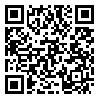Volume 25, Issue 3 (Autumn 2024)
jrehab 2024, 25(3): 464-475 |
Back to browse issues page
Download citation:
BibTeX | RIS | EndNote | Medlars | ProCite | Reference Manager | RefWorks
Send citation to:



BibTeX | RIS | EndNote | Medlars | ProCite | Reference Manager | RefWorks
Send citation to:
Gerivani H, Takian A, Sajadi H S, Shirazikhah M, Joghataei M T. Translation of the Rapid Assistive Technology Assessment Tool and Assessing Its Face Validity. jrehab 2024; 25 (3) :464-475
URL: http://rehabilitationj.uswr.ac.ir/article-1-3443-en.html
URL: http://rehabilitationj.uswr.ac.ir/article-1-3443-en.html
Hossein Gerivani1 

 , Amirhossein Takian *2
, Amirhossein Takian *2 

 , Haniye Sadat Sajadi3
, Haniye Sadat Sajadi3 

 , Marzieh Shirazikhah4
, Marzieh Shirazikhah4 

 , Mohammad Taghi Joghataei5
, Mohammad Taghi Joghataei5 




 , Amirhossein Takian *2
, Amirhossein Takian *2 

 , Haniye Sadat Sajadi3
, Haniye Sadat Sajadi3 

 , Marzieh Shirazikhah4
, Marzieh Shirazikhah4 

 , Mohammad Taghi Joghataei5
, Mohammad Taghi Joghataei5 


1- Department of Health Management, Policy and Economics, School of Public Health, Tehran University of Medical Sciences, Tehran, Iran.
2- Department of Health Management, Policy and Economics, School of Public Health, Tehran University of Medical Sciences, Tehran, Iran. ,takian@tums.ac.ir
3- Knowledge Utilization Research Center, University Research and Development Center, Tehran University of Medical Sciences, Tehran, Iran.
4- Social Determinants of Health Research Center, Social Health Research Institute, University of Social Welfare and Rehabilitation Sciences, Tehran, Iran.
5- Department of Anatomy, Faculty of Medicine, Iran University of Medical Sciences, Tehran, Iran.
2- Department of Health Management, Policy and Economics, School of Public Health, Tehran University of Medical Sciences, Tehran, Iran. ,
3- Knowledge Utilization Research Center, University Research and Development Center, Tehran University of Medical Sciences, Tehran, Iran.
4- Social Determinants of Health Research Center, Social Health Research Institute, University of Social Welfare and Rehabilitation Sciences, Tehran, Iran.
5- Department of Anatomy, Faculty of Medicine, Iran University of Medical Sciences, Tehran, Iran.
Abstract: (6124 Views)
Objective The global demand for assistive technology (AT) is extensive, with over 2.5 billion people requiring one or more assistive devices. This number is expected to increase to 3.5 billion by 2050. AT empowers individuals to enjoy a healthy, productive, and independent life. It has become a global priority, recognizing the importance of improving access to AT for those in need. Accurate measurement of the demand and accessibility of these technologies is crucial for effective action in this area. The World Health Organization (WHO) has developed the rapid assistive technology assessment tool (rATA) to address this need. This tool serves to measure the utilization and requirement of AT among populations. This study aims to introduce and explain the steps taken to translate the rATA tool and examine its face validity in Iran.
Materials & Methods After receiving authorization from WHO, the English version of rATA was translated into Persian by two proficient experts in rehabilitation. Subsequently, a backward translation was conducted by two experts who were fluent in both Persian and English. Following a consensus on the resulting version, an expert panel comprising seven professionals in rehabilitation and health was established to validate the face validity of the Persian version. Necessary modifications were implemented based on their feedback and approval.
Results The Persian version of the rATA consists of seven sections and 42 questions. These sections include preliminary information/administrative survey data, demographics, AT need assessment, supply and demand, satisfaction, recommendations, surveyor’s comments, and post-survey administration. As per the expert committee’s decision, an additional question was incorporated into the preliminary information section, and the answer choices now include an option for further AT providers.
Conclusion The Persian version of the rATA serves as a valuable tool for gathering data on the demand and accessibility of AT within the Iranian context. These data can aid decision-makers and policymakers in devising strategies to enhance access to AT, ultimately contributing to the goal of achieving universal health coverage. Furthermore, due to its potential for global applicability, the rATA questionnaire can be utilized for inter-country comparisons, providing insights into Iran’s status regarding access to AT. Additionally, it can serve as a reliable platform for policy learning, facilitating the exchange of reliable and evidence-based policies among different countries.
Materials & Methods After receiving authorization from WHO, the English version of rATA was translated into Persian by two proficient experts in rehabilitation. Subsequently, a backward translation was conducted by two experts who were fluent in both Persian and English. Following a consensus on the resulting version, an expert panel comprising seven professionals in rehabilitation and health was established to validate the face validity of the Persian version. Necessary modifications were implemented based on their feedback and approval.
Results The Persian version of the rATA consists of seven sections and 42 questions. These sections include preliminary information/administrative survey data, demographics, AT need assessment, supply and demand, satisfaction, recommendations, surveyor’s comments, and post-survey administration. As per the expert committee’s decision, an additional question was incorporated into the preliminary information section, and the answer choices now include an option for further AT providers.
Conclusion The Persian version of the rATA serves as a valuable tool for gathering data on the demand and accessibility of AT within the Iranian context. These data can aid decision-makers and policymakers in devising strategies to enhance access to AT, ultimately contributing to the goal of achieving universal health coverage. Furthermore, due to its potential for global applicability, the rATA questionnaire can be utilized for inter-country comparisons, providing insights into Iran’s status regarding access to AT. Additionally, it can serve as a reliable platform for policy learning, facilitating the exchange of reliable and evidence-based policies among different countries.
Keywords: Assistive products, Assistive technology, Disability, Rapid assistive technology assessment tool (rATA), Translation, Validity, Iran
Type of Study: Original |
Subject:
Rehabilitation Management
Received: 10/01/2024 | Accepted: 28/02/2024 | Published: 1/10/2024
Received: 10/01/2024 | Accepted: 28/02/2024 | Published: 1/10/2024
Send email to the article author
| Rights and permissions | |
 |
This work is licensed under a Creative Commons Attribution-NonCommercial 4.0 International License. |





